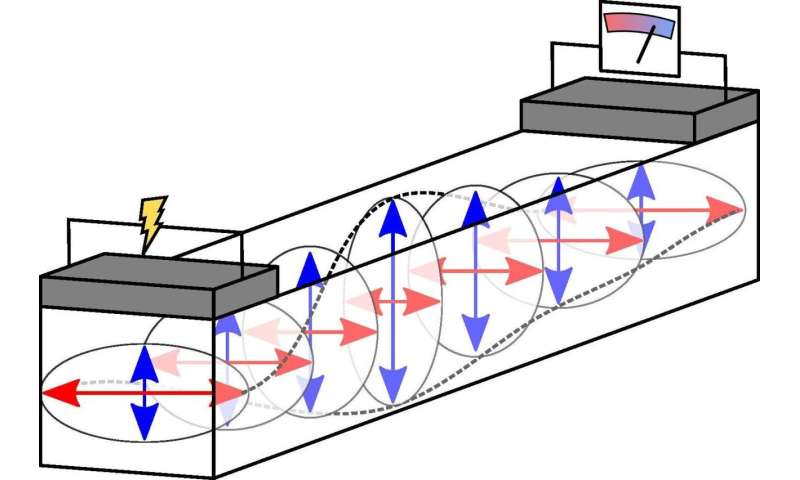
Be it with smartphones, laptops, or mainframes: The transmission, processing, and storage of info is presently centered on a one course of material—as it was in the early days of laptop or computer science about 60 yrs back. A new course of magnetic components, nevertheless, could elevate facts know-how to a new amount. Antiferromagnetic insulators help computing speeds that are a thousand situations faster than regular electronics, with drastically fewer heating. Factors could be packed closer with each other and logic modules could thus turn out to be lesser, which has so far been confined due to the enhanced heating of present components.
Information transfer at area temperature
So much, the issue has been that the data transfer in antiferromagnetic insulators only labored at lower temperatures. But who wants to place their smartphones in the freezer to be ready to use it? Physicists at Johannes Gutenberg College Mainz (JGU) have now been ready to get rid of this shortcoming, jointly with experimentalists from the CNRS/Thales lab, the CEA Grenoble, and the National Substantial Field Laboratory in France as properly as theorists from the Middle for Quantum Spintronics (QuSpin) at the Norwegian University of Science and Technological innovation. “We had been in a position to transmit and process info in a typical antiferromagnetic insulator at space temperature—and to do so above extended adequate distances to help facts processing to take place”, mentioned JGU scientist Andrew Ross. The scientists employed iron oxide (α-Fe2O3), the principal part of rust, as an antiferromagnetic insulator, due to the fact iron oxide is popular and simple to manufacture.
The transfer of information and facts in magnetic insulators is built doable by excitations of magnetic get recognised as magnons. These shift as waves by means of magnetic elements, identical to how waves go throughout the water floor of a pond after a stone has been thrown into it. Earlier, it was believed that these waves should have round polarization in purchase to effectively transmit data. In iron oxide, this kind of round polarization occurs only at low temperatures. Having said that, the international analysis group was equipped to transmit magnons around exceptionally extended distances even at area temperature. But how did that get the job done?
“We realized that in antiferromagnets with a solitary plane, two magnons with linear polarization can overlap and migrate collectively. They enhance every single other to kind an approximately round polarization,” discussed Dr. Romain Lebrun, researcher at the joint CNRS/Thales laboratory in Paris who beforehand labored in Mainz. “The risk of using iron oxide at area temperature makes it an perfect playground for the improvement of ultra-fast spintronic equipment dependent on antiferromagnetic insulators.”
Particularly low attenuation allows for electricity-productive transmission
An vital concern in the approach of details transfer is how promptly the info is lost when transferring by means of magnetic components. This can be recorded quantitatively with the value of the magnetic damping. “The iron oxide examined has just one of the most affordable magnetic attenuations that has at any time been claimed in magnetic elements,” stated Professor Mathias Kläui from the JGU Institute of Physics. “We foresee that large magnetic field procedures will demonstrate that other antiferromagnetic elements have likewise low attenuation, which is important for the improvement of a new technology of spintronic units. We are pursuing this kind of very low electrical power magnetic systems in a long-expression collaboration with our colleagues at QuSpin in Norway and I am happy to see that another piece of remarkable operate as appear out of this collaboration.”
The analysis has been revealed just lately in Character Communications.
New devices based on rust could lessen excessive heat in computer systems
R. Lebrun et al, Prolonged-length spin-transport across the Morin phase changeover up to home temperature in ultra-low damping single crystals of the antiferromagnet α-Fe2O3, Nature Communications (2020). DOI: 10.1038/s41467-020-20155-7
Citation:
Physicists use antiferromagnetic rust to carry information and facts about prolonged distances at home temperature (2020, December 10)
retrieved 10 December 2020
from https://phys.org/information/2020-12-physicists-antiferromagnetic-rust-distances-space.html
This document is issue to copyright. Aside from any reasonable working for the goal of non-public analyze or investigation, no
aspect may be reproduced with out the written authorization. The material is delivered for facts functions only.





More Stories
eSIMs for Tourists of India
(CETX), (CSCW) – 12 Details Technological know-how Shares Relocating In Wednesday’s After-Current market Session
(BRQS), (CLSK) – 12 Information Technologies Shares Moving In Wednesday’s Right after-Market place Session